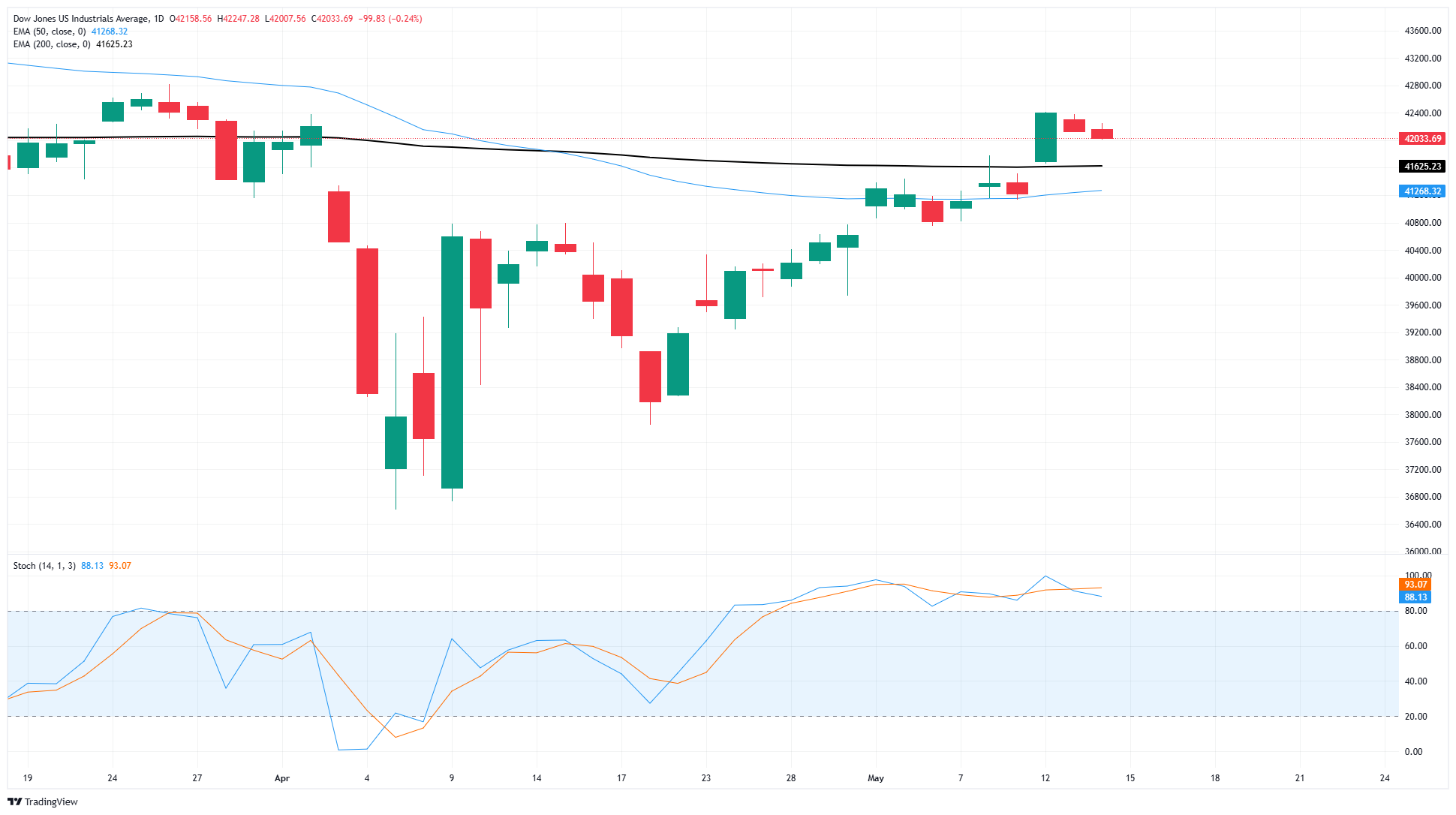Created
: 2025.05.15














![]() 2025.05.15 02:15
2025.05.15 02:15
The Dow Jones Industrial Average (DJIA) eased slightly lower on Wednesday, slipping back toward the 42,000 handle as equity markets spin in place during a calm midweek market session. Most of the major equity indexes have clawed back YTD losses, thanks in no small part to a determined bullish tilt in tech stocks.
There is a notable gap between key data releases this week, and traders are getting some room to breathe before the next batch of figures drops. United States (US) Producer Price Index (PPI) inflation data is slated for Thursday, alongside US Retail Sales. Annualized PPI is expected to ease slightly to 3.1% from 3.3%, while April's MoM figure is expected to tick up to 0.3% from -0.1%. Retail Sales in April are also expected to ease to a flat 0.0% from March's revised 1.5%.
Market experts warned that this April's dual inflation prints this week could be the last bright spot on the years-long inflation fight. According to analysts, economic impacts from the Trump administration's ham-handed trade strategies are expected to begin showing up in the data in May. Even as the Trump team explores pulling back on its own tariff policies, the Effective Tariff Rate (ETR) on most countries will hold above 13%, a number that has typically averaged somewhere near 2.5% in the past. Even with the White House's cancellation of triple-digit tariffs on China, the US's ETR on Chinese goods is expected to remain over 30% for the next quarter. Despite President Donald Trump's insistence that "other countries" will be paying the tariffs, import taxes are generally charged at the entry point into the domestic economy and extracted from domestic businesses, who tend to pass those costs onto consumers directly.
In the face of rising costs being levied directly against the US by its own administration, Friday's University of Michigan (UoM) Consumer Sentiment Index is unlikely to show much improvement. US consumers are growing increasingly apprehensive about their economic outlook and income expectations. However, median market forecasts are hoping for a slight uptick in the UoM's key sentiment reading, with the index expected to tick up to 53.4 from its two-year low of 52.2.
Read more stock news: UnitedHealth Group stock recovers Wednesday downgrades
The Dow Jones has stopped its early-week ascent, slowing down and resting near 42,000. The major equity index is still up around 1.15% this week and has recovered approximately 14% since the significant drop to the 36,600 area in early April. This week's topside breach of the 200-day Exponential Moving Average (EMA) around 41,500 has shifted the Dow Jones back into bullish territory, prompting buyers to aim for continued momentum to push prices back towards record highs exceeding 45,000.

The Dow Jones Industrial Average, one of the oldest stock market indices in the world, is compiled of the 30 most traded stocks in the US. The index is price-weighted rather than weighted by capitalization. It is calculated by summing the prices of the constituent stocks and dividing them by a factor, currently 0.152. The index was founded by Charles Dow, who also founded the Wall Street Journal. In later years it has been criticized for not being broadly representative enough because it only tracks 30 conglomerates, unlike broader indices such as the S&P 500.
Many different factors drive the Dow Jones Industrial Average (DJIA). The aggregate performance of the component companies revealed in quarterly company earnings reports is the main one. US and global macroeconomic data also contributes as it impacts on investor sentiment. The level of interest rates, set by the Federal Reserve (Fed), also influences the DJIA as it affects the cost of credit, on which many corporations are heavily reliant. Therefore, inflation can be a major driver as well as other metrics which impact the Fed decisions.
Dow Theory is a method for identifying the primary trend of the stock market developed by Charles Dow. A key step is to compare the direction of the Dow Jones Industrial Average (DJIA) and the Dow Jones Transportation Average (DJTA) and only follow trends where both are moving in the same direction. Volume is a confirmatory criteria. The theory uses elements of peak and trough analysis. Dow's theory posits three trend phases: accumulation, when smart money starts buying or selling; public participation, when the wider public joins in; and distribution, when the smart money exits.
There are a number of ways to trade the DJIA. One is to use ETFs which allow investors to trade the DJIA as a single security, rather than having to buy shares in all 30 constituent companies. A leading example is the SPDR Dow Jones Industrial Average ETF (DIA). DJIA futures contracts enable traders to speculate on the future value of the index and Options provide the right, but not the obligation, to buy or sell the index at a predetermined price in the future. Mutual funds enable investors to buy a share of a diversified portfolio of DJIA stocks thus providing exposure to the overall index.
![]()
Created
: 2025.05.15
![]()
Last updated
: 2025.05.15

FXStreet is a forex information website, delivering market analysis and news articles 24/7.
It features a number of articles contributed by well-known analysts, in addition to the ones by its editorial team.
Founded in 2000 by Francesc Riverola, a Spanish economist, it has grown to become a world-renowned information website.
We hope you find this article useful. Any comments or suggestions will be greatly appreciated.
We are also looking for writers with extensive experience in forex and crypto to join us.
please contact us at [email protected].
Disclaimer:
All information and content provided on this website is provided for informational purposes only and is not intended to solicit any investment. Although all efforts are made in order to ensure that the information is correct, no guarantee is provided for the accuracy of any content on this website. Any decision made shall be the responsibility of the investor and Myforex does not take any responsibility whatsoever regarding the use of any information provided herein.
The content provided on this website belongs to Myforex and, where stated, the relevant licensors. All rights are reserved by Myforex and the relevant licensors, and no content of this website, whether in full or in part, shall be copied or displayed elsewhere without the explicit written permission of the relevant copyright holder. If you wish to use any part of the content provided on this website, please ensure that you contact Myforex.
Myforex uses cookies to improve the convenience and functionality of this website. This website may include cookies not only by us but also by third parties (advertisers, log analysts, etc.) for the purpose of tracking the activities of users. Cookie policy